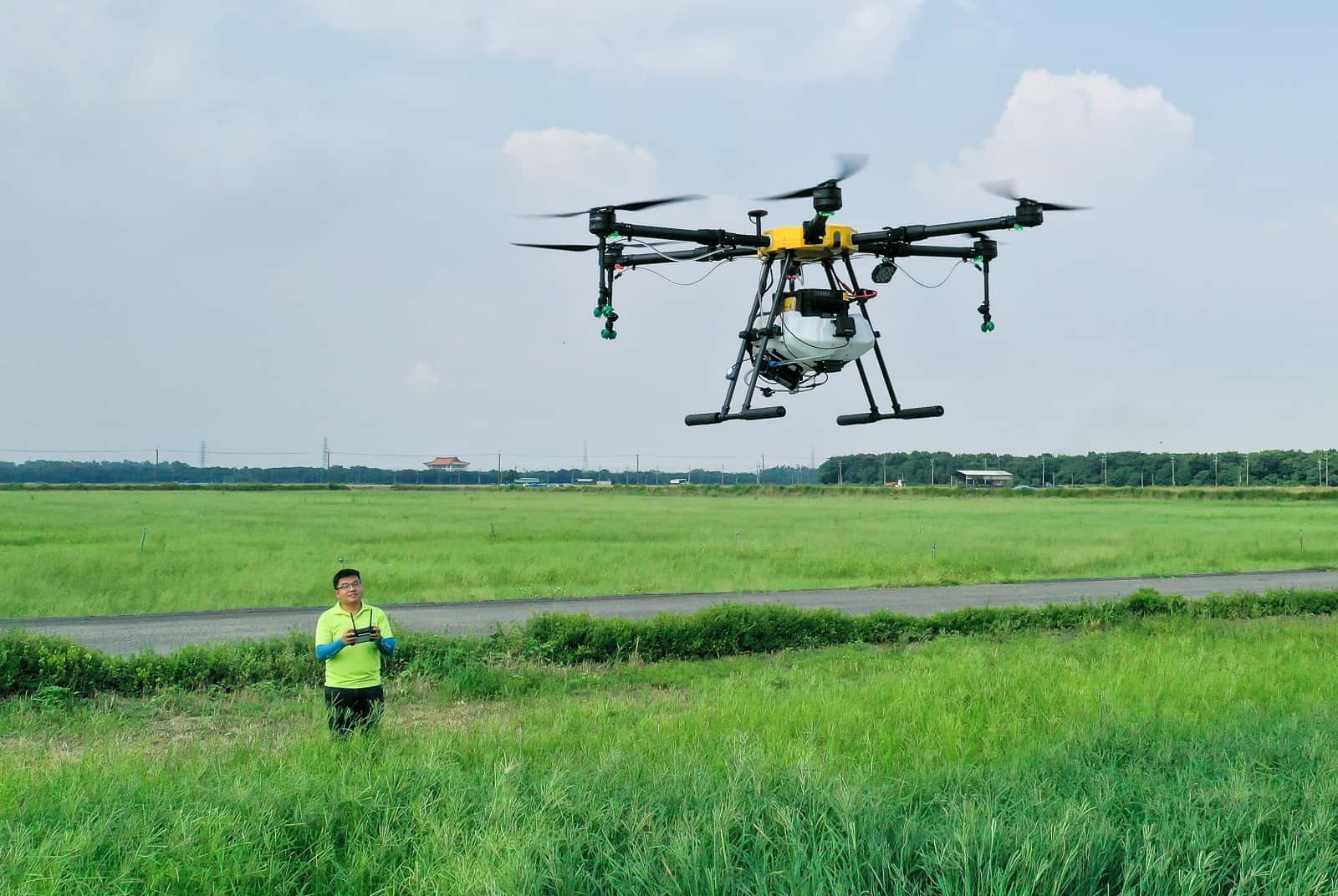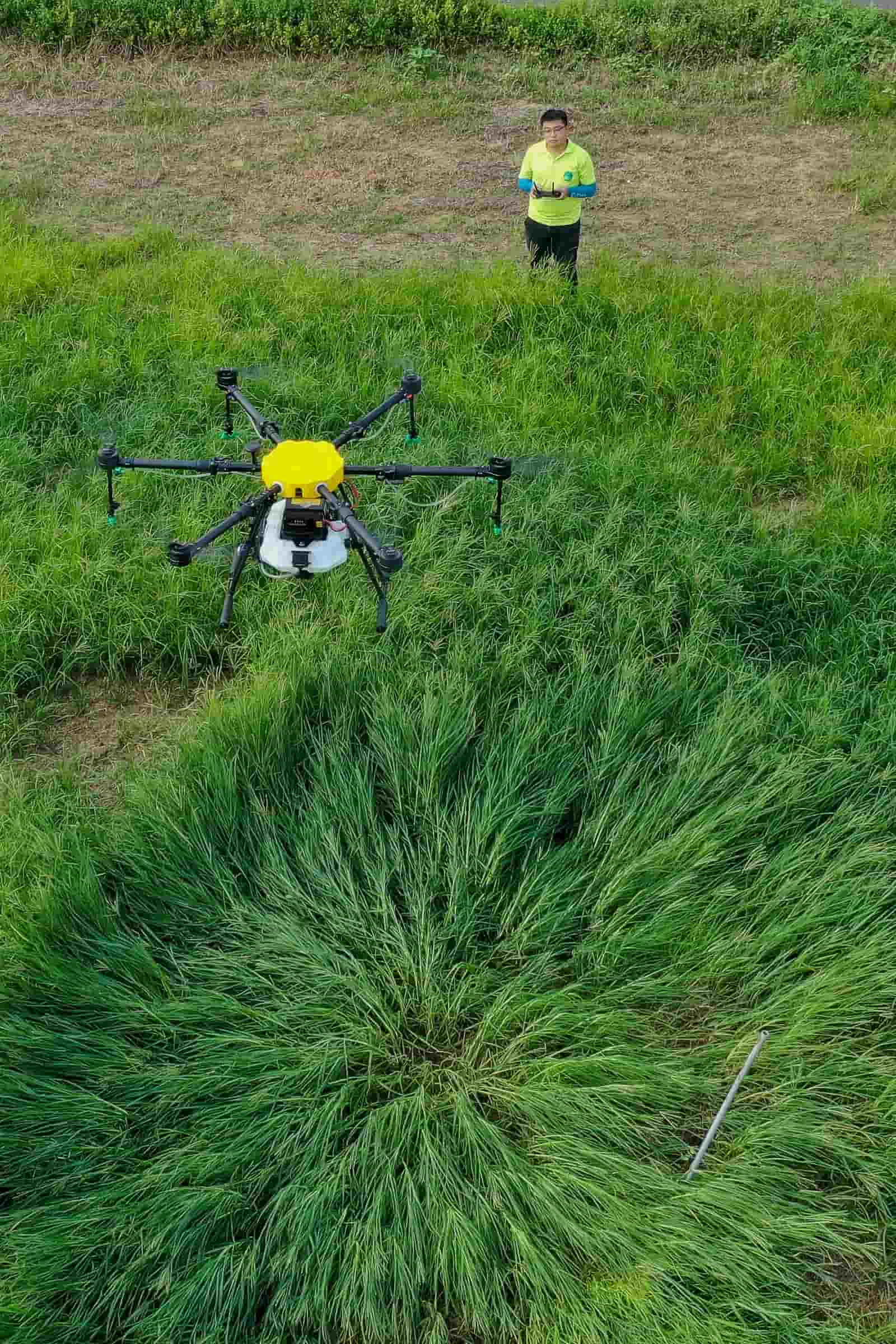Taiwan drones solve agricultural labor shortage

Source:Chien-Ying Chiu
Currently, 80 percent of Taiwan’s crops are sprayed with pesticides using drones, not only lessening the burden on aging farmers, but also conserving the use of pesticides. Drone pilots have become a prized profession with the potential to earn NT$2 million a year, fostering the emergence of MIT drone startups.
Views
Taiwan drones solve agricultural labor shortage
By Jo Wen Liweb only
Hung Yueh-ming, 30, his gaze fixed on the drone, remote control in hand, watches as it rises and falls over the green fields before him.
Today there are more and more young “remote pilots” like Hung, responsible for operating drones to spray pesticides for farmers.
 (Source: Chien-Ying Chiu)
(Source: Chien-Ying Chiu)
In the past, farmers had to hire people to carry pesticide sprayers on their backs. Yet with serious manpower shortages in rural areas, older farmers are increasingly unable to bear the burden of 25-kilogram spray canisters, making drones the ideal solution.
The ability of drones to spread pesticides more evenly has the added advantage of saving over 20 percent in pesticide use versus conventional spraying via hoses.
Combined convenience, time savings, plus an aging rural population, have resulted in the use of remote pesticide pilots for 80 percent of all crops around Taiwan.
Tremendous spraying demand gives remote pilots very generous compensation.
Remote operators can spray a plot of land in just two minutes. Typically, they only have to spray around 48,500 square meters per day. At current market rates, they can earn over NT$10,000 per day for such work.
Nox Chen, founder and CEO of agricultural drone manufacturer Earthgen, observes that after just a year on the job, some agricultural drone pilots are able to save up enough money for a downpayment on a house.
However, the price they pay is not insignificant.
“During busy times I’m out there spreading for 10 hours a day, getting less than three hours of sleep a night for a month at a time,” relates Luo Jui-hao, a remote agricultural pilot in Pingtung. The income is high, but so is the price, as many pilots are prone to sun damage to their eyes in addition to the sleep deprivation they suffer.
Remote pilots must first bear startup costs.
First, qualified remote pilots must obtain two certificates, namely a pilot’s license and pesticide spreading license. Moreover, they must foot the cost of acquiring their own agricultural drone, which typically cost between NT$300,000 and $500,000, along with such gear as a truck to carry the drone, batteries, and a generator. Luo reckons conservatively that it takes at least NT$1.3 million to get off the ground.
The keys are agricultural expertise and good connections.
Hung Yueh-ming is a native of Hsinhua, in Tainan County. His grandfather was a rice farmer. After graduating from National Taipei University of Business, he decided to enter the agricultural field. First he spent five years working at the Agricultural Technology Brigade under the Council of Agriculture, helping farmers spray pesticides and spread fertilizer.
Three years ago, he could foresee a serious agricultural manpower shortage, and having established enough connections among farmers, he decided to purchase a drone and become a part-time remote pilot.
 (Source: Chien-Ying Chiu)
(Source: Chien-Ying Chiu)
Hung observes that farmers tend to trust people with actual experience growing crops, which is why quite a few pilots are also farmers.
The high pay has attracted a large group of people to the profession within a short period. It has also bred disorder and confusion.
90% ‘bandit flyers’ willing to take half pay to avoid regulation
“These days 90 percent are bandit flyers!” exclaims Luo, who also serves as the secretary of the Pingtung County Drone Pilot Professional Association.
Elaborating, he notes that current regulations require that qualified pilots, in addition to having a license, must work for an operator in order to fly legally; otherwise, they are considered “bandit flyers”. At present the Civil Aviation Administration (CAA) has issued over 10,000 drone operator licenses, and even though only a small portion of those are for agricultural usage, only a little more than 200 pilots are affiliated with an operator. This is clearly a disproportionately small ratio, yet the government has not actively gone after bandit pilots.
 (Source: Chien-Ying Chiu)
(Source: Chien-Ying Chiu)
Pilots are not willing to work for an operator because they would have to follow strict government regulations on flying. In addition to applying to the CAA for airspace clearance 15 days in advance, area traffic control measures must be undertaken under certain conditions. And following the completion of each flight, a report must be submitted to the Bureau of Animal and Plant Health Inspection and Quarantine, resulting in high administrative costs.
In contrast, bandit pilots have lower costs, and in the plains region where competition is more intense, cut-throat price competition is common. Pingtung farmer Jao Hung-jen observes that local legally certified pilots fetch around NT$300 per plot of land, but that bandit pilots coming down from central Taiwan can squeeze the rate down to NT$150.
Pilot caliber varies greatly, which carries potential risks. Jao relates that although there are frequent rumors about drones causing injury, “it just doesn’t get reported.”\
The agricultural drone market competition is also heating up.
Currently in Taiwan the most popular drones are made by Chinese company DJI, whose market share peaked over 80 percent.
Startup opportunity: MIT drones
One of Taiwan’s first agricultural drone manufacturers is Earthgen. Founder and CEO Nox Chen, 32, a graduate of National Cheng Kung University’s Department of Aeronautics and Astronautics, would like to turn the tables on the situation.
(Source: Chien-Ying Chiu)
Chen states frankly that, in contrast to DJI, which has several hundred PhD’s working on research and development, Taiwan’s drone industry has less capital, and naturally lags behind technically. Nevertheless, the key to the survival of Taiwanese-made drones, apart from state subsidies to domestically made agricultural machines that provide a price advantage, is the even more important after-sales service.
While DJI takes up to two months for repairs, Earthgen, in addition to promoting rapid repairs, also offers farmers replacement drones while repairs are underway, minimizing their losses.
Anticipating an influx of young people entering the remote pilot market, Chen holds ongoing training courses, promising to cover all tuition costs for anyone who purchases an Earthgen drone after passing the course. And pilots looking to become associated with an operator can come directly under Earthgen Technology. As a result, 80 percent of Earthgen’s customers come from its certification courses. With Earthgen and other brands carving up DJI’s market, Chen states that DJI’s market share has already fallen to 60 percent.
Chen is moved by the desolation of the rural countryside, believing that the challenges to agriculture are very clear. And as long as problems can be solved, he asserts, there will be a market.
Have you read?
- Video Report: The “Dark Heart” of Taiwan’s freedom pineapples
- Taiwan’s tea growers on the defensive against climate change
Translated by David Toman
Edited by TC Lin
Uploaded by Penny Chiang






